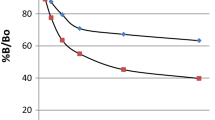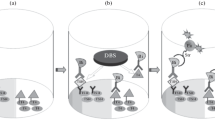Abstract
Protein A is a 56 kDa cell wall component of Staphylococcus aureus. It binds to the Fc part of the antibody with high affinity. Therefore, it can be used for the purification of antibodies in a plethora of applications. Additionally, it was applied for the immobilization of antibodies to solid supports. Herein, the development of free thyroxine radioimmunoassay (FT4 RIA) using protein A for immobilizing anti-T4 antibodies in the polystyrene tubes is described. 250µL of 5 µg/mL solution was sufficient to yield maximum coating efficiency with uniform and stable antibody-coated tubes with very less nonspecific binding. This approach was economical with respect to the consumption of antibodies and the time required for the preparation of antibody-coated tubes. This resulted in a FT4 assay with a sensitivity of 1pg/mL, with intra and inter-assay variation of less than 9.6 and 11.5% respectively, analyzed at three different FT4 concentrations. The developed system correlated well with the established FT4 RIA kit with a correlation coefficient of 0.985.




Similar content being viewed by others
References
Yingshuai L & Jie Yu 2016 Oriented immobilization of proteins on solid supports for use in biosensors and biochips: a review Microchimica Acta, volume 183, 1–19
Butler JE, Ni L, Nessler R, Joshi KS, Suter M, Rosenberg B et al (1992) 1992 The physical and functional behavior of capture antibodies adsorbed on polystyrene. J Immunol Methods 24:150: 77–90
Butler JE, Ni L, Brown WR, Joshi KS, Chang J, Rosenberg B, Voss EW Jr (1993) The immunochemistry of sandwich ELISAs. VI. Greater than 90% of monoclonal and 75% of polyclonal anti-fluorescyl capture antibodies (CAbs) are denatured by passive adsorption. Mol Immunol 30:1165–1175
Butler a JE, Ni a L, Nessler R (1992) b The physical and functionalehavior of capture antibodies adsorbed on polystyrene. Journal of Immunological Methods, 150, 77–90
Yongwon Jung, Jin Young Jeong and Bong Hyun Chung ( (2008) Recent advances in immobilization methods of antibodies on solid supports. The Analyst 2008 Jun 133(6):697–701)
Lee JE, Seo JH, Kim CS (2013) A comparative study on antibody immobilization strategies onto a solid surface. Korean J Chem Eng 30:1934–1938
Hemmila AA (ed) (Eds.) 1991 Application of fluorescence in immunoassays,Wiley, NewYork, USA,19–20
Wilfriede S, Yang T, Rees Midgley A (1987) Surface Modification with Protein A for uniform binding of monoclonal antibodies. Clin Chem 33/8:1338–1342
Lee W, Oh BK et al (2003) Fabrication of self-assembled protein A monolayer and its application as an immunosensor. Biosens Bioelectron 19:185–192
Harlow E, Lane D (eds) (Eds) 1988 Antibodies: A Laboratory Manual,Cold Spring Harbor Laboratory, New York
Rani Gnanasekar UH, Nagvekar N, Sivaprasad (2010) Development and validation of a two-step free thyroxine Radioimmunoassay based on antibody-coated tubes. J Liquid chromatography and related technologies 33:17: 1576–1586
Greenwood F, Hunter WM, Glover JS (1963) J Biochem 9:114
Odell WD (1983) In: Odell WD, Franchimont P (eds) Radiolabelling techniques, in principles of competitive protein binding assays. John Wiley & Sons Inc., New York, pp 69–83
Bhupal V, Mani RS (1986) A simple method for the determination of the specific activity of 125Itracer used in radioimmunoassay. J Radioanal Nucl Chem 107:6: 377–383
Ekins R (1982) Radioimmunoassay of Free Hormones in Blood. Free Hormones in Blood, Elsevier Biomedical Press.1982; 73–89
Shmanai VV (1999) Blocking of non-specific sorption in ELISA on formylated polystyrene beads. J Immunoass 20:13–30
Midgley JEM, Winton MRJ, Wilkins TA (1987) Relationship between effects of added albumin, initial free thyroxine value and endogenous serum-binding protein concentrations on Amerlex free thyroxine estimations. Clin Chem Acta 167:67–79
Bayer MF (1983) Free thyroxine results are affected by albumin concentrations and nonthyroidal illness. Clin Chem Acta 130:391–396
Acknowledgements
Authors thank Dr. N. Sivaprasad, Former SGM, RPH, and Dr. Grace Samuel, Former SGM, QC, RPH, BRIT for their keen interest and support in this project.
Author information
Authors and Affiliations
Corresponding author
Ethics declarations
Conflict of interest
The authors declare that they have no conflict of interest.
Additional information
Publisher’s note
Springer Nature remains neutral with regard to jurisdictional claims in published maps and institutional affiliations.
Rights and permissions
Springer Nature or its licensor holds exclusive rights to this article under a publishing agreement with the author(s) or other rightsholder(s); author self-archiving of the accepted manuscript version of this article is solely governed by the terms of such publishing agreement and applicable law.
About this article
Cite this article
Gnanasekar, R., Murhekar, V. & Kadwad, V.B. Development of solid support using protein A for the measurement of free thyroxine in human serum. J Radioanal Nucl Chem 331, 4135–4139 (2022). https://doi.org/10.1007/s10967-022-08482-z
Received:
Accepted:
Published:
Issue Date:
DOI: https://doi.org/10.1007/s10967-022-08482-z




